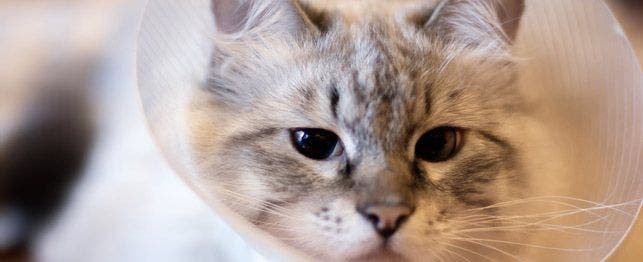
Taking Care of Your Cat After Surgery
If your cat just had surgery, or has one planned, you’ve got some work ahead of you. Whether it’s a routine procedure or something more serious, taking care of your cat after surgery requires a lot of attention and a lot of love.
Any time your cat has surgery, the recovery can be a difficult process. Every cat owner hopes that the only surgery they have to worry about is having their cat spayed or neutered, but sometimes things happen that require more serious treatment. No matter what, caring for your cat after surgery can be stressful for you, especially if it’s your first time going through it. The first day home is going to be the hardest. Getting adjusted to a new schedule, making sure you’re on time with medications, and keeping your cat comfortable will be the keys to keeping your cat’s recovery running smoothly.
Be prepared for your cat to be frustrated and/or moody, and pay extra close attention to her body language so you can understand when she’s in pain.
The first thing you should do is talk to your veterinarian or the surgeon to get a clear plan for your cat’s recovery and what should be expected in the days ahead. This will help you going forward because you’ll know how to recognize if anything goes wrong. They’ll be able to tell you what to watch for and give you a point of contact if you have any concerns. You’ll also be able to figure out if there is any specific care your cat will need during her recovery.
Once you have a solid timeline, make sure your cat is coming home to a quiet, calm environment. The last thing you want is your cat trying to do too much, or getting overly anxious because she’s overstimulated. Make sure that everyone in your home is on the same page, and try to keep visitors out of the house for the first few days.
Do’s and Dont’s for Caring for Your Cat After Surgery
Don’t …
- Feed her too soon
- Allow her to bother or lick her stitches
- Start a new diet (unless it was recommended by the veterinarian)
- Give her too much water
- Touch, groom, or brush the area where the stitches are
- Give her a bath
- Use ointments or creams that will bother the healing process (unless it was recommended by the veterinarian)
Do …
- Limit her activity
- Keep her indoors
- Keep her away from hiding spots
- Keep her away from male cats, and vice versa
- Check on the incision site daily
- Switch to shredded paper instead of litter to avoid infection
On the first day home you should also be prepared for your cat to still be feeling foggy from the anesthesia, so don’t be alarmed if she doesn’t seem like herself.
Having a nice and quiet place for your cat to rest will help your feline friend adjust after a long and arduous day. It might be in your best interest to keep her confined to one room, like a bathroom, just to make sure she’s not disturbed and she stays safe. Giving her the whole house too soon can cause problems because your cat might try to take on too much too quickly.
You’ll want to keep an eye on your cat to make sure she’s not bothering the incision site. Your veterinarian will most likely provide you with either an e-collar (the cone of shame), or a soft collar that is still a cone but less restrictive for every day activities. These collars will help keep your cat from ripping out her stitches or staples and also prevent her from causing harm to herself.
Not all surgeries will require that your cat wears a collar. Only procedures where there is a risk that your cat could damage the stitches or hurt herself will require the cone of shame.
You should be prepared to keep a constant eye on your cat, as well as her incision. You’ll want to watch for any signs of infection, but remember that the area will be red for the first few days. Your other job as caretaker is to make sure your cat is not in a great deal of pain. Sometimes it can be difficult to tell if your cat is hurting, because cats don’t often show it. You can watch for a change in behavior, vocalization, and an increased breathing pattern to tell if your kitty is in pain. It’s important to pay attention to this because if your cat is in pain, it can slow down how she’s healing because of the stress on her body.
If you can take the time to pay attention to your cat, and give her a quiet and calm environment, the process of caring for your cat after surgery won’t be too difficult. All your feline friend needs is a little TLC and she’ll be back to her usual antics in no time.